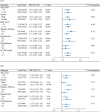Triglyceride-glucose index and the risk of heart failure: Evidence from two large cohorts and a mendelian randomization analysis
- PMID: 36329456
- PMCID: PMC9635212
- DOI: 10.1186/s12933-022-01658-7
Triglyceride-glucose index and the risk of heart failure: Evidence from two large cohorts and a mendelian randomization analysis
Abstract
Background: The relationship between triglyceride-glucose (TyG) index, an emerging marker of insulin resistance, and the risk of incident heart failure (HF) was unclear. This study thus aimed to investigate this relationship.
Methods: Subjects without prevalent cardiovascular diseases from the prospective Kailuan cohort (recruited during 2006-2007) and a retrospective cohort of family medicine patients from Hong Kong (recruited during 2000-2003) were followed up until December 31st, 2019 for the outcome of incident HF. Separate adjusted hazard ratios (aHRs) summarizing the relationship between TyG index and HF risk in the two cohorts were combined using a random-effect meta-analysis. Additionally, a two-sample Mendelian randomization (MR) of published genome-wide association study data was performed to assess the causality of observed associations.
Results: In total, 95,996 and 19,345 subjects from the Kailuan and Hong Kong cohorts were analyzed, respectively, with 2,726 cases of incident HF in the former and 1,709 in the latter. Subjects in the highest quartile of TyG index had the highest risk of incident HF in both cohorts (Kailuan: aHR 1.23 (95% confidence interval: 1.09-1.39), PTrend <0.001; Hong Kong: aHR 1.21 (1.04-1.40), PTrend =0.007; both compared with the lowest quartile). Meta-analysis showed similar results (highest versus lowest quartile: HR 1.22 (1.11-1.34), P < 0.001). Findings from MR analysis, which included 47,309 cases and 930,014 controls, supported a causal relationship between higher TyG index and increased risk of HF (odds ratio 1.27 (1.15-1.40), P < 0.001).
Conclusion: A higher TyG index is an independent and causal risk factor for incident HF in the general population.
Clinical trial registration: URL: https://www.chictr.org.cn ; Unique identifier: ChiCTR-TNRC-11,001,489.
Keywords: Heart failure; Insulin resistance; Mendelian randomization; Risk stratification; Triglyceride-glucose index.
© 2022. The Author(s).
Conflict of interest statement
These authors declare that they have no conflicts of interests.
Figures




References
-
- McDonagh TA, Metra M, Adamo M, Gardner RS, Baumbach A, Böhm M, Burri H, Butler J, Čelutkienė J, Chioncel O, et al. 2021 ESC Guidelines for the diagnosis and treatment of acute and chronic heart failure. Eur Heart J. 2021;42(36):3599–726. - PubMed
-
- Ho KL, Karwi QG, Connolly D, Pherwani S, Ketema EB, Ussher JR, Lopaschuk GD. Metabolic, structural and biochemical changes in diabetes and the development of heart failure. Diabetologia. 2022;65(3):411–23. - PubMed
Publication types
MeSH terms
Substances
Associated data
LinkOut - more resources
Full Text Sources
Medical
Research Materials
Miscellaneous

